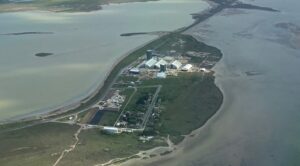SpaceX ready for Starship suborbital flight as FAA begins new environmental study
By Jeff Foust

WASHINGTON — As SpaceX prepares for the first high-altitude test flight of its Starship reusable launch vehicle, the Federal Aviation Administration is starting a new environmental review required for the company’s future launch vehicle plans.
SpaceX performed a brief static-fire test of its Starship SN8 prototype Nov. 24 at its Boca Chica, Texas, test site. After the test, company founder and chief executive declared on Twitter that the vehicle was now ready for a suborbital flight to an altitude of 15 kilometers.
“Good Starship SN8 static fire! Aiming for first 15km / ~50k ft altitude flight next week,” he tweeted. “Goals are to test 3 engine ascent, body flaps, transition from main to header tanks & landing flip.”
That flight will be the first time that a Starship vehicle has flown more than a short distance off the pad at Boca Chica. Two earlier Starship prototypes, SN5 and SN6, each performed brief “hop” tests to altitudes of no more than about 150 meters in August and September, respectively. An earlier prototype, dubbed “Starhopper,” made a similar flight in August 2019.
Musk admitted the upcoming flight was risky, giving it “maybe 1/3 chance” of being successful. However, he added, two more prototypes, SN9 and SN10, are in development.
While Starship will take off and land on its own, it is intended to be the upper stage of a launch system that features a much larger booster called Super Heavy that SpaceX is also developing at Boca Chica. However, before Super Heavy can launch from the site, SpaceX needs a new launch license from the FAA.
As part of that launch licensing effort, the FAA announced Nov. 23 that it was undertaking an environmental review of Starship/Super Heavy launches from Boca Chica. The agency said that the new vehicle “falls outside of the scope of the existing final Environmental Impact Statement (EIS) and Record of Decision for the launch site and requires additional environmental review” under federal law.
FAA completed an EIS for the Boca Chica site in June 2014 when SpaceX was proposing to build a launch site there for Falcon 9 and Falcon Heavy rockets. Instead, the company decided to use Boca Chica as a test site, and ultimately launch site, for what would become the Starship system.
Environmental organizations criticized the FAA for allowing SpaceX to change its plans for Boca Chica without revising the EIS. “They went from proposing a few launches per year of an already field-tested rocket to ongoing experimentation of untested technology without doing the studies that would ensure environmental protection and public safety and without giving the local community a chance to have a say,” said Jim Chapman, president of Friends of the Wildlife Corridor, a local environmental group.
Chapman spoke in June, shortly after another Starship prototype, SN4, exploded after a static-fire test. Three other Starship prototypes were destroyed in earlier pressurization tests dating back to November 2019.
The FAA, though, determined that Starship tests, including suborbital flights, fit within the scope of the EIS based on characteristics like noise levels and amount of pollutants generated. A June 12 report by the FAA, a revision to earlier updates of the original 2014 EIS, concluded that the Starship test plan, including 15 low- and high-altitude hop tests, “conforms to the prior environmental documentation, [and] that the data contained in the 2014 EIS remain substantially valid.” It also endorsed a SpaceX proposal to build a second test pad at the site “in the case of an anomaly on the primary test pad.”
A new environmental assessment, including potentially a new full-fledged EIS, could take significant time to complete. The original EIS for Boca Chica started with a notice of intent to develop the study in April 2012, followed by publication of a draft version a year later for public comment. The FAA published the final version more than a year after the draft report.
November 25, 2020 at 05:53PM
via SpaceNews read more...

Post a Comment